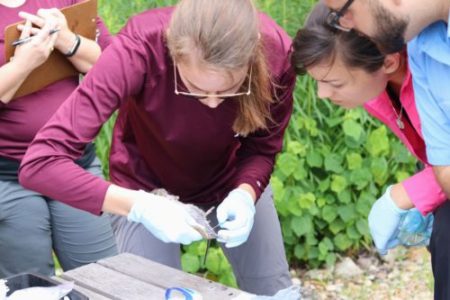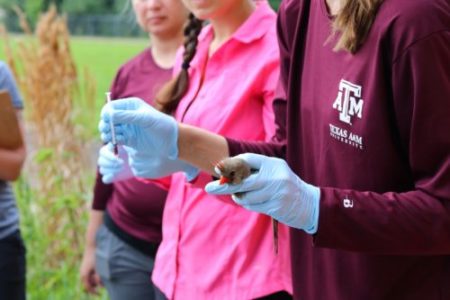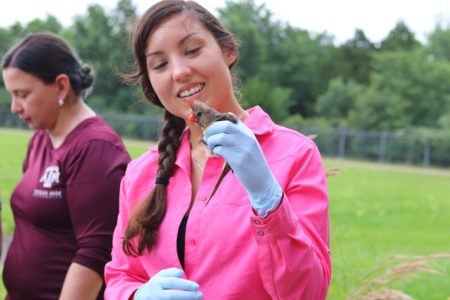CVM Collaborates on ‘One Health’ Disease Outbreak Simulation Course
Story by Megan Myers, CVMBS Communications
Texas A&M University, the University of Texas Medical Branch at Galveston (UTMB), and the University of Texas Rio Grande Valley recently collaborated on a three-week summer disease outbreak simulation course to provide students with a “One Health” view of vector-borne diseases.

At Texas A&M, the College of Veterinary Medicine & Biomedical Sciences (CVM), the Bush School of Government and Public Service, and the College of Agriculture & Life Sciences (COALS) all participated in creating content for this course.
The “Field Experience in One Health and Outbreak Investigation” course was held for the second year this summer and had 12 graduate students enrolled, most from the participating universities and one from the North Carolina State College of Veterinary Medicine. Two of these Ph.D. students came from Texas A&M, one studying biomedical sciences and the other studying industrial engineering.
“We had a mixture of students coming from a variety of different perspectives, essentially feeding into the One Health approach of tackling complex problems,” said Dr. Craig Coates, COALS instructional associate professor of entomology.
For each week of the course, the students traveled to one of the three universities to participate in workshops, field activities, and case updates for a vector-borne disease outbreak simulation.
Students were able to meet with dozens of faculty members from all three institutions, including 10 from Texas A&M, to represent the variety of people involved in real-life disease outbreak response.
“We have different expertise in different colleges,” Coates said. “The complexity of a disease outbreak from the human perspective, the pathogens, and the vectors requires people from all sorts of different places.

“The One Health perspective part of it is the understanding that even if you might be a veterinarian and you’re working on companion animals, you may come across something that would be an indicator of a disease that could be transmitted to humans,” he said.
The first week of the course took place at UT Rio Grande Valley, where students practiced tick identification, visited a USDA facility studying the cattle fever tick, and received the first pieces of information about the simulated disease outbreak.
The second week, at Texas A&M, began with lectures on a community health perspective on an outbreak response, bioterrorism, genetic engineering of vectors, and other relevant topics. The COALS’s Department of Entomology hosted lectures and workshops throughout the week in the Heep Center rooms and laboratories.
Next, the students toured the Texas A&M Veterinary Medical Diagnostic Laboratory and spent Tuesday evening setting mosquito traps in The Gardens at Texas A&M, which were gathered the next morning to practice mosquito identification.
Throughout the week, the students continued to receive updates on the disease outbreak simulation and used the knowledge they were accumulating to identify the possible disease vector and pathogen, and develop response strategies.
Later in the week, Dr. Sarah Hamer, CVM associate professor and director of the Schubot Exotic Bird Health Center, took the students to a local field site, managed by the Texas A&M Department of Wildlife & Fisheries, to teach them how to trap wild animals, including common disease reservoir hosts such as birds and rodents.
“We saw all of the things that we had captured and we brought all of those mammals or birds back to a central area so the students could get hands-on processing,” Hamer said. “We were able to plunge students right in so they could get experience with blood draws and holding birds.

“I think that was a lot of fun for them to be able to get up close and personal with the animals and learn how that is important from an outbreak perspective,” she said.
For the third week of the course, students visited the UTMB to focus on the human side of a disease outbreak response. At the end of the week, they participated in a mock media conference to learn how to educate the general public on a spreading disease.
This course was one of five the CVM is funding with the 2018-2019 Tier One Program (TOP) educational grant “Translating Science into Policy: Preparing for Pandemics and Bioterror Attacks” granted to Andrew Natsios, director of the Scowcroft Institute of International Affairs, Dr. Gregory Brian Colwell, director of the Program on Global Health Research at the Texas A&M School of Public Health, and Dr. Gerald Parker, CVM associate dean of Global One Health, director of the Biosecurity and Pandemic Policy Program at the Bush School, and strategic advisor of the Institute for Infectious Animal Diseases in AgriLife Research.
This grant is largely managed by Christy Blackburn, assistant research scientist at the Scowcroft Institute of International Affairs, who also conducted the first course funded by the grant.
“High-consequence disease outbreaks are becoming a new normal, and One Health experiential learning opportunities linking multiple colleges and universities are essential to prepare students for 21st century challenges,” Parker said.
###
For more information about the Texas A&M College of Veterinary Medicine & Biomedical Sciences, please visit our website at vetmed.tamu.edu or join us on Facebook, Instagram, and Twitter.
Contact Information: Jennifer Gauntt, Interim Director of CVM Communications, Texas A&M College of Veterinary Medicine & Biomedical Sciences; jgauntt@cvm.tamu.edu; 979-862-4216


